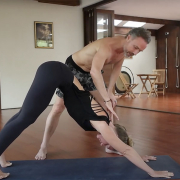 https://samahitaretreat.com/wp-content/uploads/2021/04/SAM_2698-scaled.jpg
1707
2560
Dr. Paul Dallaghan
http://samahitaretreat.com/wp-content/uploads/2024/01/samahita-logo-v2.svg
Dr. Paul Dallaghan2023-06-07 04:54:272024-02-15 09:46:19What is your state of mind? Perhaps yoga has some insight!
https://samahitaretreat.com/wp-content/uploads/2021/04/SAM_2698-scaled.jpg
1707
2560
Dr. Paul Dallaghan
http://samahitaretreat.com/wp-content/uploads/2024/01/samahita-logo-v2.svg
Dr. Paul Dallaghan2023-06-07 04:54:272024-02-15 09:46:19What is your state of mind? Perhaps yoga has some insight!Understanding Yoga & Fitness
If you have ever asked why do yoga and fitness? Isn’t my yoga my fitness anyway? What kind of workout goes well with yoga? How to do yoga to fit a workout? Or still don’t know why a longterm yoga practitioner would also embrace other workouts, then please read all, or part, of the following to get an understanding as to the genesis of YogaCoreCycle and how the bigger picture of yoga requires such activity, within moderation. I have gone deep into yoga practice and scientific research, understanding the subtle side of practice and our evolutionary history and how the body works, discussed it with experienced yogis and scientists, all convinced this is a positive step forward for people doing yoga-asana and those involved in fitness.
Nurture the spirit – take care of the body

I have been a dedicated yogi for many years. I recognize life and all its elements, needs of the body and mind. Yoga practice has been most helpful for this. I also appreciate music, food, knowledge, relationships, intimacy, conversation, entertainment and recreation, all the threads in the fabric of life. I avoid that which causes me or others harm, in body and mind, and embrace whatever makes complete sense. The practice of yoga is vital for life, nurturing of the spirit, but we cannot expect it to give all that the body needs. Yoga in a larger sense understands this and advises a combination of activities and guidance in how to perform them. In its original form, yoga-asana separated the workout from the asana. YogaCoreCycle embraces the various needs of the human body by offering a multi-modal program that separates out yoga-asana from cardio and functional fitness workouts, while offering them across a daily program.
Incomplete body-breath-mind development in modern yoga
I have taught yoga practice and the breath to more than 20,000 people over 20 years in many countries around the world. Over time I found many got stuck in a repetitive pattern of how to do asana, limiting the body’s development, were not connected to their core at all though often thinking they were, had not properly refined the breath, and would not really put in the time to sit, breathe, contemplate, look within, self-examine, considering the asana practice as yoga. Without the latter yoga practice is ineffective. Assuming yoga practice complete due to a long asana practice has led some to limit their growth in a yogic and meditative way, while also not fully taking care of the body.
Yoga is more than the physical practice
Yoga is an ancient and refined practice whose physical aspects have become an integral part of the thoroughly modern boutique fitness craze. The physical part of yoga is designed to refine and condition the body’s form and physiology. Those interested choose to live and practice it in different ways. In reality, more people relate to yoga as a physical form rather than its intended purpose as a fully integrated life system that, through internal processes, creates an understanding of who we really are. Body posture, termed as asana, is included within yoga practice and it has been developed as an extremely effective physiological and anatomical management form under Hatha yoga. It is only part of an overall process and, if to be effective within the greater purpose, needs to be done so breath and heartrate are managed. This produces a different body chemistry and physiological profile, in support of a meditative internal growth.

Yoga-asana is not a replacement for exercise
The human body needs different forms of care and stimulation, as our evolution has shown. Yoga and fitness experts have consistently found that asana is not a replacement for exercise. When yoga is undertaken solely for fitness purposes, much of its meaning and effect is lost. It is limited. Yoga does not provide the cardiovascular benefits of a full workout program, such as indoor cycling, and a repetitive asana practice can cause practitioners to lose touch with messages their bodies communicate. Though a physical asana practice, coupled with breathing, can do wonders for the body it is still not designed to push the heart and breath in a workout.
Both yoga-asana and exercise are needed for a healthy body
Changing the way the body moves, as in switching between a yoga-asana, a core, and a cycle class, helps to identify postural concerns, weak muscles, and other issues that may be preventing practitioners from fully performing the yoga poses or finding balance in their bodies. A fitness workout stimulates the nervous system one way that is beneficial, if not overdone, yet different to how yoga-asana affects the nerves and equally the body chemistry.
Exercise is one thing that is essential in people’s lives, yoga practice is another. In addition to that are the yogic practices of pranayama-breath and sitting-meditation. All together these cover the whole person – the body and the mind, the gross and the subtle, the worldly and the spiritual. Great health and wellbeing arises from addressing all needs of an individual.
Yoga-asana and exercise optimize how the body functions
As yoga-asana with breathing stimulates more the parasympathetic nervous system and massages a different hormonal and neurotransmitter profile into the blood stream, benefitting a clearer, calmer state for most of the day, exercise, whether more cardio or resistance-based strength work, is needed to engage the sympathetic in a healthy way, counter to stress-based sympathetic responses, and trigger a different chemical cocktail for a period of time through the body. This ebb and flow, yin and yang, alternated stimulation, optimizes how the body functions. Interestingly this aids the meditative process more due to its greater balancing effects and more robust neuro-physiological operation.

Manage body chemistry between core, cardio, and asana
Functional fitness integrates perfectly as part of any level of a yoga practitioner’s regular routine. It is especially important to build the Core, as that is the system of muscles that supports the entire body. Connecting with the physical Core builds endurance and efficiency, reducing the possibility of injuries. The movement part of an asana practice is ideal to incorporate Core work. The aim is to recruit as many muscles of the body as possible at one time to help strengthen, optimize fat burning, and develop real core support. Such full body strength work can then switch to a restorative phase, that asana can provide, so the chemicals released into the body to build strength and burn fat can now be removed from circulation and the body can have a repair and restore impact, opening body tissue, impacting lymph drainage, nurturing the nervous system, and improving the circulatory system.
Human evolution demands support of our core
The human body has evolved to its current bipedal form, with a unique big toe alignment, based purely on the fact that we Homo sapiens started to actively use our legs and walk everywhere, literally over this entire earth. The human S-shaped spinal column is a direct result of that development and, in consequence, the large muscles the legs use and the nerves off the lower part of the spine to the pelvis and legs. Though strength exists in the upper body too we are pathetically weak there compared to fellow primates but champion them with our legs. Our arms to hands to fingers instead have developed incredible technologies, from basic tools to today’s modern technology. However, this upright stance has led to challenges on the vertebral column support with many of the population suffering from back issues and internal organ ailments. Core support from the lower abdomen is essential for this support and health. A proper yoga asana practice identifies this but many reduce to flexibility exercises. Further core work is essential. Some activity at least a few days a week is needed for lymph stimulation as well as circulation and elimination stimulation.
Recent human history involved a mixture of work and activity
Until very recently, literally within the last decade, without the convenience of modern technology, we moved more and had to more manual activities. In older days a yoga practitioner would also have to walk for miles a day (BKS Iyengar would love to tell the story of how he had to walk 10 miles a day just to teach, on top of his asana practice – now that’s a “workout”), or climb hills if living in mountainous regions of India, or work in the fields given the majority of the population were agrarian.
Still a few questions?
Does yoga need cardio?
Does yoga need more core work?
Is Yoga a workout or not?
What about yoga tradition?
So, is yoga practice still evolving?
Dr. Paul Dallaghan’s expertise with breathwork, body and meditative practices comes from three sources: (1) three decades of daily dedicated practice and teaching these techniques; (2) uniquely acknowledged in the Yoga tradition by the title of “Master Yogi-Prānācharya (expert in breath)”, following an immersion in the original culture through one-on-one direct training in practice and study of ancient texts; (3) a PhD in doctoral scientific research at a leading US university (Emory) covering both the tradition and science of yoga and breath practices in terms of stress, health and aging. As a result, Paul occupies a unique space to impart genuine teaching and science on the breath, body, and meditative practices, seen as a Teacher-of-teachers and identified to carry on the tradition of Pranayama. His sincere and ongoing role is to teach, write and research, to help put out experienced and authentic information on these areas of how we live, breathe and be, to help people improve their mental and physical health, and live more fulfilling lives.
For more on his background see his bio
More from the Samahita Blog








